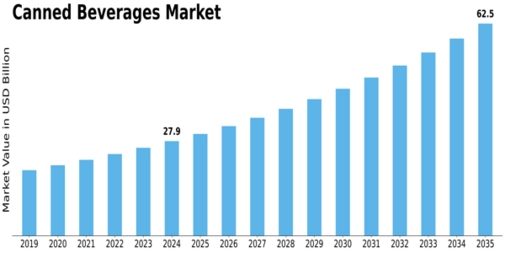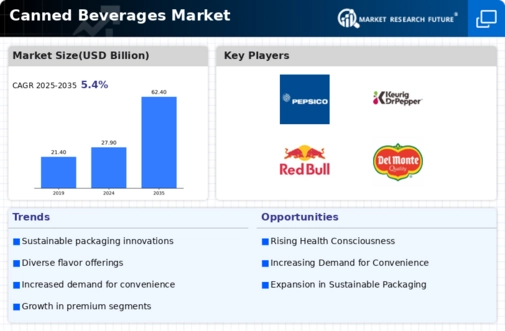-
Executive Summary
-
Scope of the Report
-
Market Definition
-
Scope of the Study
- Research Objectives
- Assumptions & Limitations
-
Market Structure
-
Market Research Methodology
-
Research Process
-
Secondary Research
-
Primary Research
-
Forecast Model
-
Market Landscape
-
Supply Chain Analysis
- Raw Material Suppliers
- Manufacturers/Producers
- Distributors/Retailers/Wholesalers/E-Commerce
- End Users
-
Porter’s Five Forces Analysis
- Threat of New Entrants
- Bargaining Power of Buyers
- Bargaining Power of Suppliers
- Threat of Substitutes
- Internal Rivalry
-
Market Dynamics of Global Canned Beverages Market
-
Introduction
-
Drivers
-
Restraints
-
Opportunities
-
Challenges
-
Global Canned Beverages Market, by Type
-
Introduction
-
Alcoholic Beverages
- Market Estimates & Forecast, 2024–2032
- Market Estimates & Forecast, by Region, 2024–2032
-
Non-Alcoholic Beverages
- Market Estimates & Forecast, 2024–2032
- Market Estimates & Forecast, by Region, 2024–2032
- Carbonated Soft Drinks
- Fruit & Vegetable Juices
- Others
-
Global Canned Beverages Market, by Distribution Channel
-
Introduction
-
Store Based
- Supermarkets & Hypermarkets
- Convenience Stores
- Others
-
Non-Store Based
- Market Estimates & Forecast, 2024–2032
- Market Estimates & Forecast, by Region, 2024–2032
-
Global Canned Beverages Market, by Region
-
Introduction
-
North America
- Market Estimates & Forecast, 2024–2032
- Market Estimates & Forecast, by Type, 2024–2032
- Market Estimates & Forecast, by Distribution Channel, 2024–2032
- US
- Canada
- Mexico
-
Europe
- Market Estimates & Forecast, 2024–2032
- Market Estimates & Forecast, by Type, 2024–2032
- Market Estimates & Forecast, by Distribution Channel, 2024–2032
- Germany
- France
- Italy
- Spain
- UK
- Rest of Europe
-
Asia-Pacific
- Market Estimates & Forecast, 2024–2032
- Market Estimates & Forecast, by Type, 2024–2032
- Market Estimates & Forecast, by Distribution Channel, 2024–2032
- China
- India
- Japan
- Australia & New Zealand
- Rest of Asia-Pacific
-
Rest of the World (RoW)
- Market Estimates & Forecast, 2024–2032
- Market Estimates & Forecast, by Type, 2024–2032
- Market Estimates & Forecast, by Distribution Channel, 2024–2032
- South America
- The Middle East
- Africa
-
Company Landscape
-
Introduction
-
Market Strategy
-
Key Development Analysis
-
(Expansions/ Mergers and Acquisitions/ Joint Ventures/ New Product Developments/ Agreements/ Investments
-
Company Profiles
-
PepsiCo
- Company Overview
- Financial Updates
- Product/Business Segment Overview
- Strategy
- Key Developments
- SWOT Analysis
-
The Coca-Cola Company
- Company Overview
- Financial Updates
- Product/Business Segment Overview
- Strategy
- Key Developments
- SWOT Analysis
-
Keurig Dr Pepper Inc.
- Company Overview
- Financial Updates
- Product/Business Segment Overview
- Strategy
- Key Developments
- SWOT Analysis
-
RED BULL
- Company Overview
- Financial Updates
- Product/Business Segment Overview
- Strategy
- Key Developments
- SWOT Analysis
-
The Family Coppola
- Company Overview
- Financial Updates
- Product/Business Segment Overview
- Strategy
- Key Developments
- SWOT Analysis
-
Del Monte Fresh
- Company Overview
- Financial Updates
- Product/Business Segment Overview
- Strategy
- Key Developments
- SWOT Analysis
-
E. & J. Gallo Winery
- Company Overview
- Financial Updates
- Product/Business Segment Overview
- Strategy
- Key Developments
- SWOT Analysis
-
The Boston Beer Company
- Company Overview
- Financial Updates
- Product/Business Segment Overview
- Strategy
- Key Developments
- SWOT Analysis
-
Precept Wine
- Company Overview
- Financial Updates
- Product/Business Segment Overview
- Strategy
- Key Developments
- SWOT Analysis
-
Left Hand Brewing Co.
- Company Overview
- Financial Updates
- Product/Business Segment Overview
- Strategy
- Key Developments
- SWOT Analysis
-
Conclusion
-
LIST OF TABLES
-
Global Canned Beverages Market, by Region, 2024–2032 (USD Million)
-
Global Canned Beverages Market, by Type, 2024–2032 (USD Million)
-
Global Canned Beverages Market, by Distribution Channel, 2024–2032 (USD Million)
-
North America: Canned Beverages Market, by Country, 2024–2032 (USD Million)
-
North America: Canned Beverages Market, by Type, 2024–2032 (USD Million)
-
North America: Canned Beverages Market, by Distribution Channel, 2024–2032 (USD Million)
-
US: Canned Beverages Market, by Type, 2024–2032 (USD Million)
-
US: Canned Beverages Market, by Distribution Channel, 2024–2032 (USD Million)
-
Canada: Canned Beverages Market, by Type, 2024–2032 (USD Million)
-
Canada: Canned Beverages Market, by Distribution Channel, 2024–2032 (USD Million)
-
Mexico: Canned Beverages Market, by Type, 2024–2032 (USD Million)
-
Mexico: Canned Beverages Market, by Distribution Channel, 2024–2032 (USD Million)
-
Europe: Canned Beverages Market, by Country, 2024–2032 (USD Million)
-
Europe: Canned Beverages Market, by Type, 2024–2032 (USD Million)
-
Europe: Canned Beverages Market, by Distribution Channel, 2024–2032 (USD Million)
-
Germany: Canned Beverages Market, by Type, 2024–2032 (USD Million)
-
Germany: Canned Beverages Market, by Distribution Channel, 2024–2032 (USD Million)
-
France: Canned Beverages Market, by Type, 2024–2032 (USD Million)
-
France: Canned Beverages Market, by Distribution Channel, 2024–2032 (USD Million)
-
Italy: Canned Beverages Market, by Type, 2024–2032 (USD Million)
-
Italy: Canned Beverages Market, by Distribution Channel, 2024–2032 (USD Million)
-
Spain: Canned Beverages Market, by Type, 2024–2032 (USD Million)
-
Spain: Canned Beverages Market, by Distribution Channel, 2024–2032 (USD Million)
-
UK: Canned Beverages Market, by Type, 2024–2032 (USD Million)
-
UK: Canned Beverages Market, by Distribution Channel, 2024–2032 (USD Million)
-
Rest of Europe: Canned Beverages Market, by Type, 2024–2032 (USD Million)
-
Rest of Europe: Canned Beverages Market, by Distribution Channel, 2024–2032 (USD Million)
-
Asia-Pacific: Canned Beverages Market, by Country, 2024–2032 (USD Million)
-
Asia-Pacific: Canned Beverages Market, by Type, 2024–2032 (USD Million)
-
Asia-Pacific: Canned Beverages Market, by Distribution Channel, 2024–2032 (USD Million)
-
China: Canned Beverages Market, by Type, 2024–2032 (USD Million)
-
China: Canned Beverages Market, by Distribution Channel, 2024–2032 (USD Million)
-
India: Canned Beverages Market, by Type, 2024–2032 (USD Million)
-
India: Canned Beverages Market, by Distribution Channel, 2024–2032 (USD Million)
-
Japan: Canned Beverages Market, by Type, 2024–2032 (USD Million)
-
Japan: Canned Beverages Market, by Distribution Channel, 2024–2032 (USD Million)
-
Australia & New Zealand: Canned Beverages Market, by Type, 2024–2032 (USD Million)
-
Australia & New Zealand: Canned Beverages Market, by Distribution Channel, 2024–2032 (USD Million)
-
Rest of Asia-Pacific: Canned Beverages Market, by Type, 2024–2032 (USD Million)
-
Rest of Asia-Pacific: Canned Beverages Market, by Distribution Channel, 2024–2032 (USD Million)
-
Rest of the World (RoW): Canned Beverages Market, by Country, 2024–2032 (USD Million)
-
Rest of the World (RoW): Canned Beverages Market, by Type, 2024–2032 (USD Million)
-
Rest of the World (RoW): Canned Beverages Market, by Distribution Channel, 2024–2032 (USD Million)
-
South America: Canned Beverages Market, by Type, 2024–2032 (USD Million)
-
South America: Canned Beverages Market, by Distribution Channel, 2024–2032 (USD Million)
-
Middle East: Canned Beverages Market, by Type, 2024–2032 (USD Million)
-
Middle East: Canned Beverages Market, by Distribution Channel, 2024–2032 (USD Million)
-
Africa: Canned Beverages Market, by Type, 2024–2032 (USD Million)
-
Africa: Canned Beverages Market, by Distribution Channel, 2024–2032 (USD Million)
-
LIST OF FIGURES
-
Global Canned Beverages Market Segmentation
-
Forecast Research Methodology
-
Five Forces Analysis of Global Canned Beverages Market
-
Value Chain of Global Canned Beverages Market
-
Share of Global Canned Beverages Market in 2022, by Country (%)
-
Global Canned Beverages Market, by Region, 2024–2032,
-
Global Canned Beverages Market Size, by Type, 2022
-
Share of Global Canned Beverages Market, by Type, 2024–2032 (%)
-
Global Canned Beverages Market Size, by Distribution Channel, 2022
-
Share of Global Canned Beverages Market, by Distribution Channel, 2024–2032 (%)
















Leave a Comment